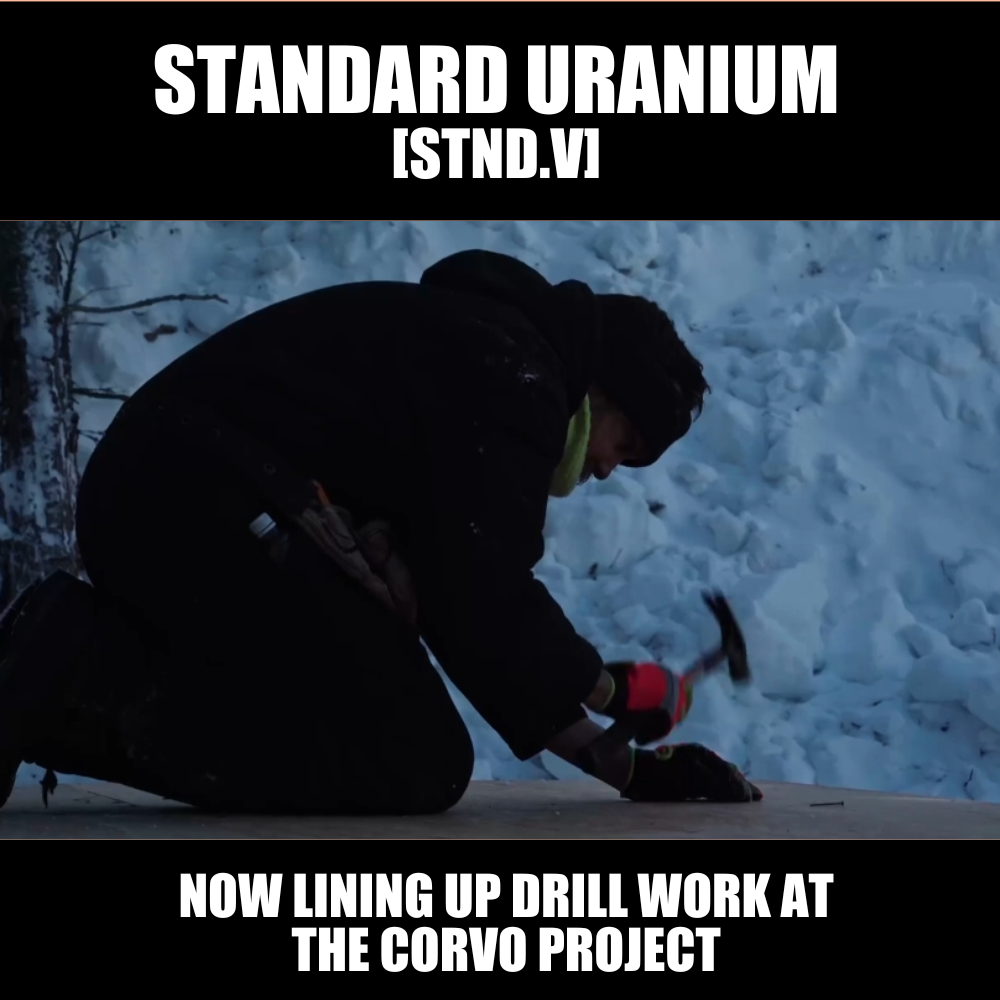 Disclaimer: This article has been paid for by Standard Uranium. See disclosures at the bottom of the page.
Disclaimer: This article has been paid for by Standard Uranium. See disclosures at the bottom of the page.
Standard Uranium (STND.V) is mobilizing crews to its Corvo Project in the eastern Athabasca Basin, kicking off summer exploration with boots on the ground, rock hammers in hand, and a clear focus: find the next shallow high-grade uranium hit before the market really wakes up to how much nuclear it’ll need.
For those unfamiliar, Corvo is one of several uranium projects held by Standard, a junior that’s carved out a tidy portfolio across the Basin’s western and eastern flanks. Unlike some uranium explorers who gather land like Pokémon cards and rarely move past the staking phase, Standard’s been actively working its ground – either directly or through partnerships – in an effort to strap a saddle to uranium’s macroeconomics upshifts.
This summer’s activity at Corvo is a result of one such partnership. In April, Standard signed a three-year earn-in deal with Aventis Energy (AVE.C), a small-cap uranium player looking to fast-track its entry into the Basin. Aventis has the option to spend $6 million all in, including payment and exploration spend, to earn 75% of the project after three years. It’s a good deal for Standard—minimal dilution, non-operator risk, and a shot at drilling success on someone else’s dime while the STND team is moving the gears on its other projects.
What’s Happening at Corvo
This year’s program starts with groundwork—literally. Prospecting and geochemical sampling will focus on known mineralized showings, including the “Manhattan Showing,” where historical surface samples graded up to 5.98% U₃O₈. That’s not just anomalous—it’s the kind of number that opens conversations.
Later this year, the plan is to layer in geophysics: a ground gravity survey to pick up alteration zones and structural traps that might host uranium. Earlier airborne surveys already flagged a long stretch of conductive anomalies that align with the historical drill hits, so the gravity data is meant to fine-tune those targets before drilling.
Speaking of drilling: it’s coming. The first holes are slated for Q1 2026. If gravity and sampling results line up the way they hope, that drill program could be a real catalyst for both Standard and Aventis.
Why This Project Matters
Corvo isn’t some random patch of brush in the middle of nowhere. It’s 45 km from Atha Energy’s Gemini discovery and just 60 km from the McArthur River mine—arguably the world’s most prolific high-grade uranium producer. That’s elite real estate.
The project’s near the edge of the Basin, meaning the sandstone layer that typically covers uranium deposits is thinner or absent. Translation: easier targets, shallower holes, and potentially quicker path to resource definition. That’s music to the ears of investors who’ve sometimes been burned by the slow death of “deep discovery” stories.
Historical work at Corvo found uranium over an 800-metre strike length between two 1970s-era drill holes. Those hits never turned into a resource, but they give Standard’s team a head start on where to focus as they pursue one.
The Bigger Picture for Standard
Corvo is just one piece of the pie. Standard Uranium has been advancing several Athabasca Basin assets simultaneously, with a strategy built around de-risking early-stage exploration assets through farm-outs and partnerships.
Its flagship project is Davidson River, in the southwest Athabasca region—home turf for NexGen and Fission’s big discoveries. While it’s had mixed drilling results there to date, the land package is large, well-positioned, and still underexplored at depth, and the company is using new tech to clarify the picture of what’s actually underground.
Then there’s Sun Dog in the northwest corner of the Basin, which has seen surface radioactivity and historical trenches. There have already been 3 drill programs on that plot, with the second funded by Aero Energy (AERO.V) and with new geo physical data acquired this year. Canary and Atlantic, two more of its projects, are earlier stage but lie along prospective corridors with strong structural signatures.
The key is Standard’s model: use industry connections and a skilled technical team to stake promising ground, then bring in partners to fund the heavy lifting. In uranium exploration, where single holes can cost upwards of $250,000, that’s a pragmatic approach.
The Macro Case: Uranium’s Clock Is Ticking
All this is happening against the backdrop of a tightening uranium market. Governments worldwide are pivoting back to nuclear power, and utilities are back in the spot market after years of living off inventories. Meanwhile, new discoveries are few and far between.
That leaves a hole—and explorers like Standard are aiming to fill it. The big mines like McArthur and Cigar Lake won’t last forever. Investors know this. The challenge is finding the right horse to back early.
With Corvo getting serious attention, Davidson River still in play, and a portfolio of Basin projects ripe for JVs, Standard Uranium is positioning itself as a “multi-ticket” explorer. It doesn’t need every project to hit—just one. And that, increasingly, looks like a decent bet.
— Chris Parry
FULL DISCLOSURE: Equity.Guru/Parry Research has an agreement with Standard Uranium and may purchase stock in the company. EG/PR does not make buy/sell recommendations but you should consider any coverage in which we show the Equity.Guru client company badge as being potentially conflicted, and any investment you make in a public company as having inherent risk. This content was approved by the company before publishing.
ISSUER-PAID ADVERTISEMENT. STANDARD URANIUM., or the “Company,” has or will pay Equity.Guru/Parry Resarch (“Publisher”) in cash $15,000 for marketing services, including advertisements. This advertisement is part of those issuer-paid marketing services. This compensation should be viewed as a major conflict with Publisher’s ability to be unbiased.
FORWARD LOOKING STATEMENTS. This publication contains forward-looking statements, including statements regarding expected continual growth of the featured company and/or industry. The Publisher notes that statements contained herein that look forward in time, which include everything other than historical information, involve risks and uncertainties that may affect the companies’ actual results of operations. Factors that could cause actual results to differ include, but are not limited to, government regulations concerning uranium production, the size and growth of the market for uranium, the companies’ ability to fund its capital requirements in the near term and long term, pricing pressures, etc.


Leave a Reply